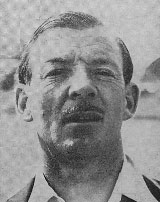
|

Peter Smith: the call-up that never was
© The Cricketer
|
|
Cricketers are renowned for practical jokes and winding up colleagues, but in August 1933 Essex's Peter Smith was the victim of a prank that bordered on cruel.
At the time Smith was 24 and a fairly new arrival to county cricket. A googly bowler and capable lower-order batsman, he had enjoyed a good summer - he was to go on and take 100 wickets for the first of six times. But given the wealth of talent available, he was certainly not in the frame for an England call-up.
On Friday, August 11, Smith was sitting in a Chelmsford cinema - Essex had no match - when a message was flashed on the screen for him to report to the county immediately. As he left the cinema he bumped into his father who was clutching a telegram from the Essex secretary instructing him to report to The Oval the following morning for the start of the third Test against West Indies. He had been called up into the 12 as injury cover.
Smith telephoned the Essex secretary who confirmed that the county had received a telegram from the MCC.
He packed his bags and caught the early train to London, arriving at The Oval in good time. He made his way to the changing-room where he sat down and starting getting his kit in order. Bob Wyatt, captaining in the absence of the injured Douglas Jardine, arrived a little later. He thought that Smith's presence was strange but said nothing.
After a while Smith hesitantly asked Wyatt where he was in the final XI or not. Wyatt had to admit he had no idea what he was talking about. The telegram had not originated from the MCC. "The poor fellow," Wyatt later wrote. "He had been made the victim of a cruel hoax. The telegram was completely bogus. I have never known such a dirty trick to be played on a cricketer before."
Had Smith had time to check that morning's papers he would have noticed his name was not in the XII. As it was, he might well have prospered as in the match, Father Marriott, an Irish-born teacher who bowled in a similar style to Smith, took 11 for 96 in what was to be his only Test. Smith returned to Essex, gaining some solace when he took his 100th wicket of the season in his next match.
It looked as if his chance had gone for good when war broke out in 1939. Smith was 31 then, and by the time cricket resumed he was 37. But 1946 was one of his most successful seasons and in August that year he received another telegram from the MCC inviting him to play for England against India ... at The Oval. Wyatt said he was almost as pleased as Smith when he heard the news. His Test debut came 13 years to the week after the hoax.
Smith did not have a particularly memorable debut - he took 1 for 58 - but he was invited to tour Australia that winter. In four Tests he took three wickets at 106.33, but given what happened in August 1933, it could have been so much worse.

